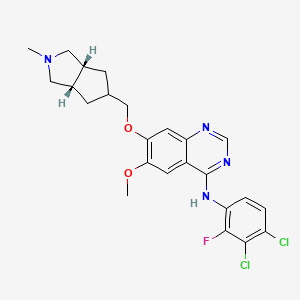Drug Information
Drug (ID: DG00082) and It's Reported Resistant Information
| Name |
Tesevatinib
|
||||
|---|---|---|---|---|---|
| Synonyms |
Tesevatinib; XL647; XL-647; 781613-23-8; EXEL-7647; UNII-F6XM2TN5A1; KD-019; XL 647; F6XM2TN5A1; 651031-01-5; 7-[[(3aS,6aR)-2-methyl-3,3a,4,5,6,6a-hexahydro-1H-cyclopenta[c]pyrrol-5-yl]methoxy]-N-(3,4-dichloro-2-fluorophenyl)-6-methoxyquinazolin-4-amine; Tesevatinib [USAN:INN]; EXEL 7647; 874286-84-7; KD 019; 1000599-06-3; SCHEMBL721994; SCHEMBL721993; SCHEMBL721992; C24H25Cl2FN4O2; GTPL7944; CHEMBL3544983; EX-A172; QCR-153; MolPort-044-724-458; BCP23438; ZINC38912363; 2809AH; AKOS027255007
Click to Show/Hide
|
||||
| Indication |
In total 5 Indication(s)
|
||||
| Structure |

|
||||
| Drug Resistance Disease(s) |
Disease(s) with Clinically Reported Resistance for This Drug
(1 diseases)
[1]
|
||||
| Target | Ephrin type-B receptor 4 (EPHB4) | EPHB4_HUMAN | [1] | ||
| Tyrosine-protein kinase (PTK) | NOUNIPROTAC | [1] | |||
| Click to Show/Hide the Molecular Information and External Link(s) of This Drug | |||||
| Formula |
C24H25Cl2FN4O2
|
||||
| IsoSMILES |
CN1C[C@H]2CC(C[C@H]2C1)COC3=C(C=C4C(=C3)N=CN=C4NC5=C(C(=C(C=C5)Cl)Cl)F)OC
|
||||
| InChI |
1S/C24H25Cl2FN4O2/c1-31-9-14-5-13(6-15(14)10-31)11-33-21-8-19-16(7-20(21)32-2)24(29-12-28-19)30-18-4-3-17(25)22(26)23(18)27/h3-4,7-8,12-15H,5-6,9-11H2,1-2H3,(H,28,29,30)/t13 ,14-,15+
|
||||
| InChIKey |
HVXKQKFEHMGHSL-GOOCMWNKSA-N
|
||||
| PubChem CID | |||||
| TTD Drug ID | |||||
| DrugBank ID | |||||
Type(s) of Resistant Mechanism of This Drug
Drug Resistance Data Categorized by Their Corresponding Diseases
ICD-02: Benign/in-situ/malignant neoplasm
| Drug Resistance Data Categorized by Their Corresponding Mechanisms | ||||
|
|
||||
| Key Molecule: Epidermal growth factor receptor (EGFR) | [1] | |||
| Molecule Alteration | Missense mutation | p.T790M |
||
| Resistant Disease | Lung adenocarcinoma [ICD-11: 2C25.0] | |||
| Experimental Note | Identified from the Human Clinical Data | |||
| In Vivo Model | A retrospective survey in conducting clinical studies | Homo sapiens | ||
| Experiment for Molecule Alteration |
Direct sequencing assay | |||
| Experiment for Drug Resistance |
Computed tomography assay | |||
| Mechanism Description | The most common mechanism of acquired resistance is caused by the development of the T790M mutation in exon 20 of EGFR in nearly 50% of patients, whereas 10% of the patients have amplification of the oncogene MET as a means of resistance. | |||
References
If you find any error in data or bug in web service, please kindly report it to Dr. Sun and Dr. Zhang.
